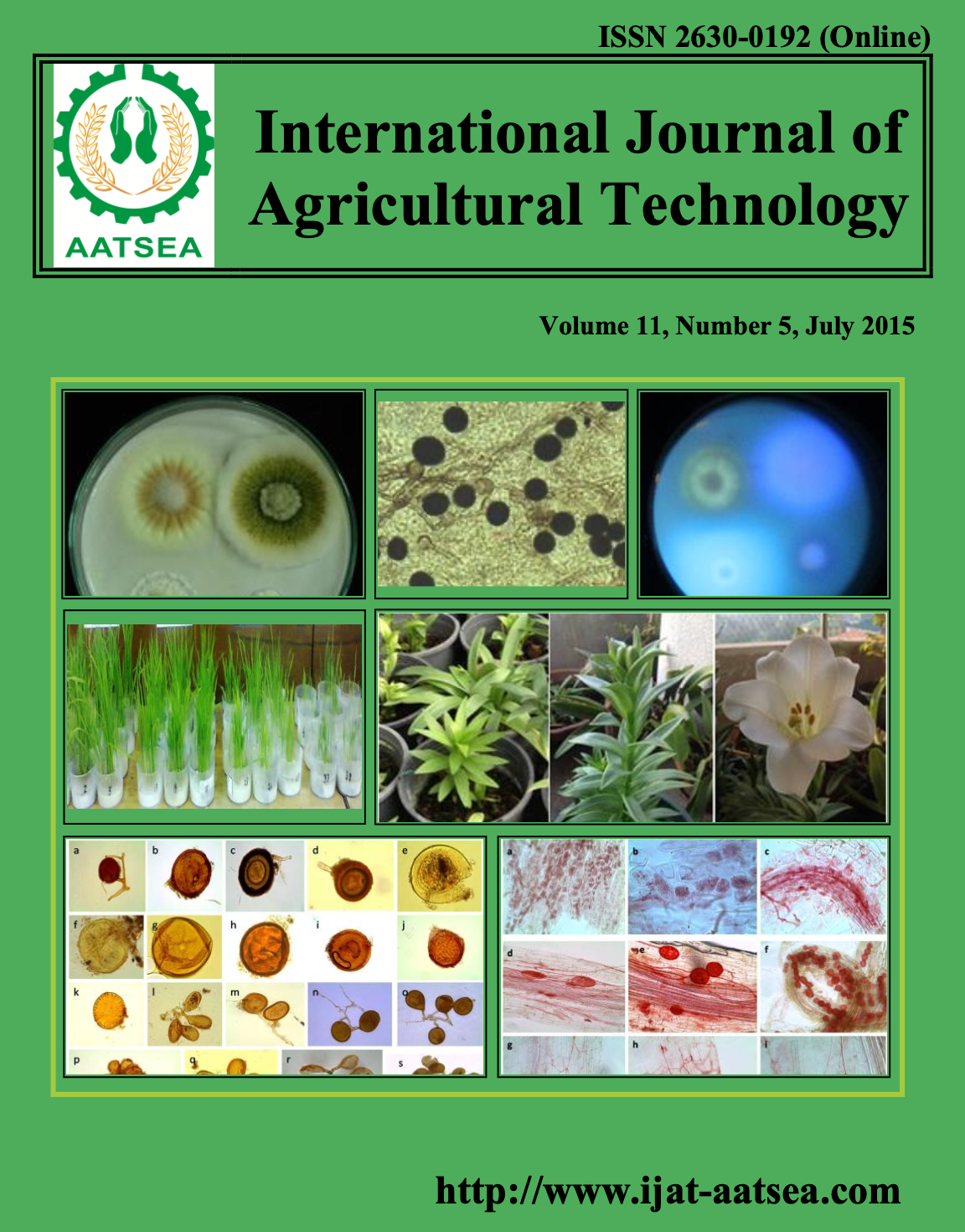Microwave assisted extraction of bioactive compounds from turmeric (Curcuma longa).
Main Article Content
Abstract
Microwave-assisted extraction (MAE) was used to extract curcuminoids from turmeric (Curcuma longa). Several MAE conditions were tested, and the method proved to be superior to soxhlet extraction and maceration with regard to time expended. The antioxidant activities of MAE and soxhlet extraction determined from 1/IC50 by the DPPH radical assay were higher than synthetic antioxidant 2, 6-di-ter-butyl-4-methylphenol (BHT). MAE exhibited a range of antioxidant activities varying from 1.37-1.87 mM TEAC/g extract in ABTS assay while soxhlet extraction and maceration were 1.72 and 1.40 mM TEAC/g extract, respectively. The total phenolic contents of MAE ranged from 181.00 to 196.36 mg/g extract; expressed as gallic acid equivalent, while soxhlet extraction and maceration were 180.10 and 170.44 mg/g extract. The contents of curcumin, demethoxycurcumin and bisdemethoxycurcumin of extracts obtained from MAE were in range of 163.00-183.77, 91.73-99.48 and 46.36-53.35 mg/g extract, respectively which were higher than soxhlet extraction. Higher curcumin content may be major contributor to its higher antioxidant activity. The optimum condition of MAE was 900 watt for 1 min of exposure time as it provided higher bioactive compounds and antioxidant activity than conventional methods.
Article Details

This work is licensed under a Creative Commons Attribution-NonCommercial-NoDerivatives 4.0 International License.
References
Abas, F., Lim, S., Ahmad, S., Stanslas, J., Israf, D. A., Shaari, K. and Lajis, N. H. (2006). Biological Evaluation of Curcumin and Related Diarylheptanoids. Verlag der Zeitschrift für Naturforschung 900:625-631.
AOAC (2000). Official methods of analysis of AOAC International, 17th edition. AOAC International, Gaithersburg, MD.
Chan, C., Yusoff, R., Ngoh, G. and Kung, F. (2011). Microwave-assisted extractions of active ingredients from plants. Journal of Chromatography A 1218:6213-6225.
Dajanta, K. (2010). Production of high nutritional fermented soybean (THUA NAO) by Bacillus subtilis. (Doctor of Philosophy’s Thesis). Chiang Mai University.
Dandekar, D. and Gaikar, V. (2001). Microwave assisted extraction of curcuminoids from Curcuma longa. Separation Science and Technology 37:2669-2690.
Goel, A., Kunnumakkara, A. and Aggarwal, B. (2008). Curcumin as ‘‘Curecumin’’: From kitchen to clinic. Biochemical Pharmacology 75:787-809.
Jyothi, D., Khanam, S. and Sultana, R. (2010). Optimization of microwave assisted solvent extraction of withanolides from leaves of ashwagandha. Pharmacie Globale (IJCP) 2:46-
Kaufmann, B. and Christen, P. (2002). Recent extraction techniques for natural products: microwave-assisted extraction and pressurised solvent extraction. Phytochemical Analysis 13:105-113.
Kähkönen, M. P., Hopia, A. I., Vuorela, H. J., Rauha, J. P., Pihlaja, K., Kujala, T. S. and Heinomen, M. (1999). Antioxidant activity of plant extracts containing phenolic compounds. Journal of Agriculture and Food Chemistry 47:3957-3962.
Kumar, G., Nayaka, H., Dharmesh, S. and Salimath, P. (2006). Free and bound phenolic antioxidants in amla (Emblica officinalis) and turmeric (Curcuma longa). Journal of Food Composition and Analysis 19:446-452.
Kuttigounder, D., Lingamallu, J. R. and Bhattacharya, S. (2011). Turmeric powder and starch: selected physical, physicochemical, and microstructural properties. Journal of Food Science 76:1284-1291.
Li, H., Deng, Z., Wu, T., Liu, R., Loewen, S. and Tsao, R. (2012). Microwave-assisted extraction of phenolics with maximal antioxidant activities in tomatoes. Food Chemistry 130:928-936.
Maisuthisakul, P., Suttajit, M. and Pongsawatmanit, R. (2007). Assessment of phenolic content and free radical-scavenging capacity of some Thai indigenous plants. Food Chemistry 100:1409-1418.
Mandal, V., Mohan, Y. and Hemamatha, S. (2008). Microwave assisted extraction of curcumin by sample–solvent dual heating mechanism using Taguchi L9 orthogonal design. Journal of Pharmaceutical and Biomedical Analysis 46:322-327.
Pan, Y., He, C., Wang, H., Ji, X., Wang, K. and Liu, P. (2010). Antioxidant activity of microwave-assisted extract of Buddleia officinalis and its major active component. Food Chemistry 121:497-502.
Proestos, C. and Komaitis, M. (2008). Application of microwave-assisted extraction to the fast extraction of plant phenolic compounds. LWT 41:652-659.
Revathy, S., Elunmalai, S., Benny, M. and Antony, B. (2011). Isolation, Purification and Identification of Curcuminoids from turmeric (Curcuma longa L.) by Column Chromatography. Journal of Experimental Sciences 2:21-25.
Rodríguez, V., Sweet, C., Timmermann, B. and Sólyom, A. (2004). Development of an LC/MS/MS method to separate and analyze curcuminoids, their metabolites and degradation products. Paper presented at the 118th AOAC International Annual Meeting and Exposition, Louis, Missouri.
Singh, G., Kapoor, I. P. S., Singh, P., de Heluani, C. S., de Lampasona, M. P. and Catalan, C. A. N. (2010). Comparative study of chemical composition and antioxidant activity of fresh and dry rhizomes of turmeric (Curcuma longa Linn.). Food and Chemical Toxicology 48:1026-1031.
Surveswaran, S., Cai, Y., Corke, H. and Sun, M. (2007). Systematic evaluation of natural phenolic antioxidants from 133 Indian medicinal plants. Food Chemistry 102:938-953.
Tiwari, P., Kumar, B., Kaur, M., Kaur, G. and Kaur, H. (2011). Phytochemical screening and Extraction: A Review. Internationale Pharmaceutica Sciencia 1:98-106.
Wu, T., Yan, J., Liu, R., Marcone, M., Aisa, H. and Tsai, R. (2012). Optimization of microwave-assisted extraction of phenolics from potato and its downstream waste using orthogonal array design. Food Chemistry 133:1292-1298.
Yoshida, T., Tsubaki, S., Teramoto, Y. and Azuma, J. (2010). Optimization of microwave-assisted extraction of carbohydrates from industrial waste of corn starch production using response surface methodology. Bioresource Technology 101:7820-7826.
Zhang, H., Yang, X. and Wang, Y. (2011). Microwave assisted extraction of secondary metabolites from plants: Current status and future directions. Trends in Food Science & Technology 22:672-688.
Zhang, H. F., Zhang, X., Yang, X. H., Qiu, N. X., Wang, Y. and Wang, Z. Z. (2013). Microwave assisted extraction of flavonoids from cultivated Epimedium sagittatum: Extraction yield and mechanism, antioxidant activity and chemical composition. Industrial Crops and Products 50:857-865.
Zebib, B., Mouloungui, Z. and Noirot, V. (2010). Stabilization of curcumin by complexation with divalent cations in glycerol/water System. Bioinorganic Chemistry and Applications 2010:1-8.


